Jamb
| Author:Laxman Burdak, IFS (R) |
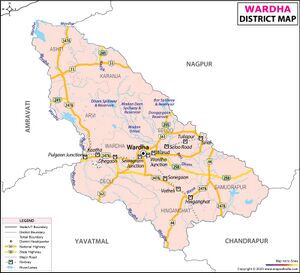
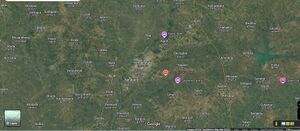
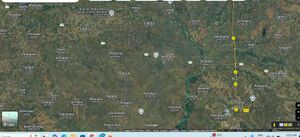
Jamb (जांब) is a n ancient historical village in Samudrapur tahsil in Wardha district of Maharashtra. It is known for Jamb Plates Of 2nd year of Pravarasena II.[1]
Variants
Origin
Location
Jat Gotras Namesake
- Jambh (जम्भ) (Jat clan) → Jamb (जांब) is an ancient historical village in Samudrapur tahsil in Wardha district of Maharashtra. It is known for Jamb Plates Of 2nd year of Pravarasena II.[2]
Jamb Plates of 2nd year of Pravarasena II
[p.10]: These plates were discovered, in 1940, in the possession of one Baburao Madhavrao Athole, Mokasdar of Jamb (जांब), a village, about 7 miles north by east of Hinganghat, in the Hinganghat tahsil of the Wardha District in Vidarbha. They were edited by me with facsimiles in the Epigraphia Indica, Vol. XXVI, pp. 155 f. They are edited here from the same facsimiles.
The copper-plates are four in number, each measuring 8" by 4’-11" . The first and fourth plates are inscribed on one side only, and the remaining two on both the sides. When the plates were first seen by me, they were held together by a ring, but its ends were neither joined by a pin nor soldered. The seal which it must have carried is not forthcoming now. All the plates are in a good state of preservation, and consequently there is no uncertainty in the reading anywhere. The weight of the four plates is 185 tolas and that of the ring is 16 tolas.
The record consists of 36 lines, six being written on each inscribed face of the four plates. The characters are of the box-headed variety. .....The language is Sanskrit, and except for an imprecatory verse in lines 34-35, the record is in prose throughout. As regards orthography, we find that consonants are reduplicated before and after r as in parākkram-, line 5, and mūrddh-, line 6; th is reduplicated before in Bhāgiratthy-, line 6, and visarga before p is changed to upadhmānīya in lines 13, 15 and 33.
The record opens with the word drishṭam, ‘ seen ’. The plates were issued by Pravarasena II of the Vakataka dynasty from Nandivardhana. In the introductory portion of the grant his genealogy is traced from Samrat Pravarasena I, the Maharaja of the Vakataka (dynasty). He belonged to the Vishnuvriddha gotra and performed several Vedic sacrifices such as Agnishtoma, Aptoryama, Ukthya, Shodasin, Atiratra, Vajapeya, Brihaspatisava and Sadyaskra as well as four Asvamedhas.
He was succeeded by his grandson Rudrasena I, the son of Gautamiputra from the daughter of Bhavanaga, the Maharaja of the Bharasivas. The royal family of the Bharasivas is said to have been created by the god Shiva who was pleased by their carrying his linga on their shoulders. They performed ten Ashvamedhas and were crowned with the water of the Bhagirathi (Ganga) which they had obtained by their valour.
Maharaja Rudrasena I was a fervent devotee of Svami-Mahabhairava. He was succeeded by his son Maharaja Prithivishena (I), who was a fervent devotee of Maheshvara. He was endowed with several noble qualities and ruled for a long time, having sons and grandsons as well as a large army and a treasure which had been accumulating for a hundred years. His son was Maharaja Rudrasena II, who is said to have acquired
[p.11]: royal fortune by the grace of Chakrapani (Vishnu). His son from Prabhavatigupta, the daughter of Maharajadhiraja Devagupta, was Maharaja Pravarasena II, who was a devout worshipper of Maheshvara. As stated before, this Devagupta is none other than Chandragupta II -Vikramaditya, the illustrious Emperor of the Gupta dynasty.
The object of the present inscription is to record the grant, by Pravarasena II, of the village Kothuraka which was situated in the āhāra (territorial division) of Supratishtha (सुप्रतिष्ठाहार). The village lay to the west of the river Uma, to the north of Chinchapalli (चिंचापल्ली), to the east of Bonthikavataka (बोन्थिकवाटक) and to the south of Mandukigrama (मण्डूकिग्राम). The donee was the celibate Brahmana Kaluttaka (कालूट्टक), who belonged to the Kaundinya gotra and the Taittiriya shakha of the Black Yajurveda. The grant was made at the victorious place of religious worship (vaijayika dharmasthana) and is dated on the twelfth tithi of the bright fortnight of Asvina in the second regnal year. The Dutaka was Chakradeva, and the scribe Nagavarman.
The donee of the present plates is called gaṇa-yājin. It may therefore be conjectured that the grant was made on the occasion of a gaṇa-yāga (गणयाज) at which he officiated as a priest. The Manusmriti (III, 164) enjoins that a sacrificer of the Gaṇas should be avoided at a shraddha. The expression gaṇānām yājakaḥ is variously interpreted by the commentators of Manu1, but Buhler’s suggestion2 that the reference may be to the gana-homas mentioned in the Baudhāyana-Dharmasutra seems to be preferable. These gana-homas were to be performed by a person for himself. A Brahmana is, however, allowed to perform the rite for his teacher, father and mother, but for none else. If he performs it for others through greed, he is tainted by sin and perishes like one who has swallowed poison. Baudhayana, however, says later on (IV, 8, 10) that through a desire of removing one’s guilt one may cause these oblations to be offered by men who have been engaged for money in case one is unable to do it; a man need not torment himself. This means, as explained by the commentator Govindasvamin, that the wealthy man who engages a priest for the performance of the rite will be freed from sin, but the latter will be tainted by guilt3. This explains why the priests who performed gana-homas for others out of greed were avoided at a sraddha. Naturally few persons must have come forward to do the rite and those who did it received a high reward. The case is analogous to that of the first annual srhaddha in honour of a dead person or to that of a shraddha at an eclipse. The donee of the present plates seems to have performed such a gana-homa for Pravarasena II, from whom he received a village as his sacrificial fee.
As for the localities mentioned in the present grant, Nandivardhana (नन्दिवर्द्धन) has already been identified with Nandardhan or Nagardhan near Ramtek in the Nagpur District.
Kothurarka (कोथुरक), the donated village, cannot now be traced. Its site seems to have been occupied by Mangaon (माणगाँव) on the right bank of the Wunna, about 2-1/2 miles north by west of Jamb, since all the boundary villages mentioned in the present plates can be identified in its vicinity in their respective directions. Thus
Chinchapalli (चिंचापल्ली) is Chincholi which also is situated on the right bank of the same river Wunna, half a mile to the south of Mangaon (माणगाँव);
Bonthikavataka (बोन्थिकवाटक) is now called Bothad (बोथड़) and
Mandukigrama (मण्डूकिग्राम), Mandgaon (माण्डगाँव), about 3-1/2 miles to the north by west and 2 miles to the north respectively from Mandgaon. The Wardha District Gazetteer records a tradition that Mandgaon is named after one Mando Rishi who is said to have done penance on the Wunna river. The present grant, however, shows that the ancient name of the place
1. For other interpretations of gana-yāga, see Ep. Ind., Vol. XXVI, pp. 157 f.
2. See his Laws of Manu, S.B.E., Vol. XXV, p. 106.
3. See Gavindasvamin’s commentary on Baudhāyana-Dharamasutra, IV, 8, 9.
[p.12]: was Mandukigrama. The identification of these three boundaries shows that the river Uma which formed the eastern boundary of the donated village is none other than the Wunna.
As shown before, Supratishtha the headquarters of the āhāra in which these villages were situated comprised roughly the territory now included in the Hinganghat tahsil of the Wardha District.
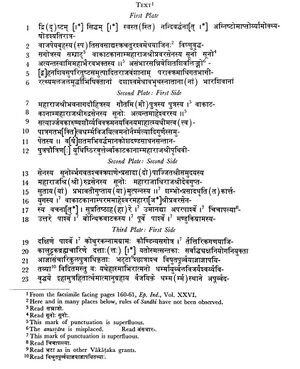
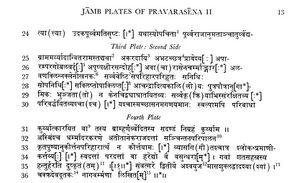
Seen. Success ! Hail ! From Nandivardhana —
By the order of the illustrious Pravarasena (II), the Maharaja of the Vakatakas, who is a fervent devotee of Maheshvara, who, by the grace of Shambhu, has established the Kritayuga (Golden Age) (on the earth), who was born of Prabhavatigupta, the daughter of the Maharajadhiraja, the illustrious Devagupta, and who is the son of the Maharaja, the illustrious Rudrasena (II), who acquired an abundance of prosperity by the grace of the Divine (Lord) Chakrapani (Vishnu), and who16 was the son of the illustrious Prithivishena (I), the Maharaja of the Vakatakas, who was intensely devoted to (the god) Maheshvara, who was endowed with truthfulness, straightforwardness, compassion, heroism, valour, political wisdom, modesty, high-mindedness, intelligence, devotion to worthy persons, and with the state of being a righteous conqueror, purity of mind, and such other qualities, who had sons and grandsons and a continuous supply of treasure and army which had been accumulating for a hundred years, who conducted himself like Yudhishthira, and who was the son of the illustrious Rudrasena (I), the Maharaja of the Vakatakas and the son of
16. i.e. Rudrasena II.
[p.14]: Gautamiputra, who was intensely devoted to (the god) Svami-Mahabhairava, who was the daughter’s son of the illustrious Bhavanaga, the Maharaja of the Bharasivas, whose royal family was created by Shiva, who was greatly pleased by (their) carrying the linga of Shiva like a load placed on (their) shoulder, and who were besprinkled on their head with the pure water of the (river) Bhagirathi that had been obtained by their valour, who1 was the son of the illustrious Pravarasena (I), the Maharaja of the Vakatakas, the Samrat (Universal Monarch), who performed the Agnishtoma, Aptoryama, Ukthya, Shodasin, Atiratra, Vajapeya, Brihaspatisava, Sadyaskra and four Asvamedhas, and who was of the Vishnuvriddha gotra.
(Line 17). The village named Kothuraka (कोथुरक) situated in the āhāra of Supratishtha, which (is) to the west of the river Uma, to the north of Chinchapalli (चिंचापल्ली), to the east of Bonthikavataka (बोन्थिकवाटक) (and) to the south of Mandukigrama (मण्डूकिग्राम), has been donated (by Us) to the Brahmacharin (named) Kaluttoka (कालूट्टक), who has performed a gana-yāga (गणयाज) and who belongs to the Taittiriya shakhs .
(Line 20). Wherefore, Our officials of noble birth, who are employed by the order of the Sarvādhyaksha (General Superintendent) and who exercise their authority by (Our) command, and (Our) soldiers and policemen2 should be directed by the (following) command which is already well-known (to them) : —
“Be it known to you that in order to increase Our religious merit, life, power, victory and prosperity, to secure Our well-being in this world and the next and to obtain blessings for Ourself, We have given here in (Our) victorious place of religious worship, with the pouring out of water, (this village) as a gift not previously made.
And We grant the following exemptions which are incidental to a village bestowed on a Brahmana proficient in the four Vedas and are appropriate, as approved by former kings: — It is not to pay taxes; it is not to be entered by soldiers and policemen; it does not entitle (the State) to customary cows and bulls3; it does not (also) entitle it to (royalties on) flowers and milking; it is exempt from (the obligation to provide) grass, hides as seats and charcoal (to touring royal officers)4; it is exempt from (royalties on) the purchase of fermenting liquors and the digging of salt5; it is free from all kinds of forced labour; it is donated together with (the right to) hidden treasures and deposits (and) together with major and minor taxes6; it is to be enjoyed as long as the sun and the moon (will endure) and it is to follow the succession of sons and son’s sons. None should cause an obstruction while (the donee or his successor) is enjoying it. (This grant) should be preserved and increased by all means. And whoever, disregarding Our order, will himself cause or make (others) cause even the slightest obstruction, upon him, when complained against by the Brahmanas, We will inflict punishment together with a fine ”.
(Line 32). In showing thus Our regard to religion. We, in order to avoid mention
1 R. Bhandarkar suggested that sunoh sunoh in line 3 refers to Gautamiputra, who succeeded Pravarasena I. The construction is no doubt faulty. It would be better to read Gautamiputra- putrasya as in No. 13, line 9. There is no doubt that Gautamiputra did not reign. See the absence of the title Vākātakānām Mahārāja in his case. For the probable reason for the faulty construction. see Ind. Cul. Vol. XI, pp. 232 f.
2 See above, p. 9, n. 1.
3 Fleet translated, 'It does not carry with it (the right to) cows and bulls in succession of production’ and remarked that the interpretation here was not quite certain. Perhaps, the right to demand the first calf of a cow is referred to here.
4 See above, p. 9, n. 2.
5 See above, p. 9, n. 3.
6 See above, p. 9, n. 5.
[p.15]: of the meritorious deeds already done, do not refer to (Our) care and protection of the grants of many past kings.
And the following verse sung by Vyasa should be regarded as an authority on this point : —
(Here occurs an imprecatory verse.)
(Line 35). (This charter has been written) by Nagavarman on the twelfth (lunar day) of the bright (fortnight) of the month Asvayuja in the second (regnal) year, Chakradeva being the Dutaka.
Wiki editor Notes
- Bharshiv (भारशिव) (Jat clan) → Bharshivas (भारशिव) are mentioned in Jamb Plates of 2nd year of Pravarasena II[3]....Pravarasena II was succeeded by his grandson Rudrasena I, the son of Gautamiputra from the daughter of Bhavanaga, the Maharaja of the Bharasivas. The royal family of the Bharasivas is said to have been created by the god Shiva who was pleased by their carrying his linga on their shoulders. They performed ten Ashvamedhas and were crowned with the water of the Bhagirathi (Ganga) which they had obtained by their valour.
- Both (बोथ) (Jat clan) → Bothuda is an ancient historical village in Samudrapur tahsil in Wardha district of Maharashtra. It has been mentioned as Bonthikavataka (बोन्थिकवाटक) in Jamb Plates of 2nd year of Pravarasena II[4]
- Jambh (जम्भ) (Jat clan) → Jamb (जांब) is an ancient historical village in Samudrapur tahsil in Wardha district of Maharashtra. It is known for Jamb Plates Of 2nd year of Pravarasena II.[5]
- Koth (कोथ) (Jat clan) → Kothurarka (कोथुरक) = Mangaon (माणगाँव) is an ancient historical village in Samudrapur tahsil in Wardha district of Maharashtra. It is at the site of village mentioned as Kothurarka (कोथुरक) in Jamb Plates of 2nd year of Pravarasena II[6]
- Man (मान) (Jat clan) → Mangaon (माणगाँव) is an ancient historical village in Samudrapur tahsil in Wardha district of Maharashtra. It is at the site of village mentioned as Kothurarka (कोथुरक) in Jamb Plates of 2nd year of Pravarasena II[7]
- Mand (मांड) (Jat clan) → Mandgaon (माण्डगाँव) is an ancient historical village in Samudrapur tahsil in Wardha district of Maharashtra. It has been mentioned as Mandukigrama (मण्डूकिग्राम) in Jamb Plates of 2nd year of Pravarasena II[8]
- Naga (नागा) (Jat clan) → Nagavarman. The charter of Jamb Plates of 2nd year of Pravarasena II was written by Nagavarman on the twelfth (lunar day) of the bright (fortnight) of the month Asvayuja in the second (regnal) year, Chakradeva being the Dutaka.[9]
History
Notable persons
Gallery
External links
References
- ↑ Corpus Inscriptionum Indicarum Vol.5 (inscriptions Of The Vakatakas), Edited by Vasudev Vishnu Mirashi, 1963, Archaeological Survey of India, p.10-15
- ↑ Corpus Inscriptionum Indicarum Vol.5 (inscriptions Of The Vakatakas), Edited by Vasudev Vishnu Mirashi, 1963, Archaeological Survey of India, p.10-15
- ↑ Corpus Inscriptionum Indicarum Vol.5 (inscriptions Of The Vakatakas), Edited by Vasudev Vishnu Mirashi, 1963, Archaeological Survey of India, p.10-15
- ↑ Corpus Inscriptionum Indicarum Vol.5 (inscriptions Of The Vakatakas), Edited by Vasudev Vishnu Mirashi, 1963, Archaeological Survey of India, p.10-15
- ↑ Corpus Inscriptionum Indicarum Vol.5 (inscriptions Of The Vakatakas), Edited by Vasudev Vishnu Mirashi, 1963, Archaeological Survey of India, p.10-15
- ↑ Corpus Inscriptionum Indicarum Vol.5 (inscriptions Of The Vakatakas), Edited by Vasudev Vishnu Mirashi, 1963, Archaeological Survey of India, p.10-15
- ↑ Corpus Inscriptionum Indicarum Vol.5 (inscriptions Of The Vakatakas), Edited by Vasudev Vishnu Mirashi, 1963, Archaeological Survey of India, p.10-15
- ↑ Corpus Inscriptionum Indicarum Vol.5 (inscriptions Of The Vakatakas), Edited by Vasudev Vishnu Mirashi, 1963, Archaeological Survey of India, p.10-15
- ↑ Corpus Inscriptionum Indicarum Vol.5 (inscriptions Of The Vakatakas), Edited by Vasudev Vishnu Mirashi, 1963, Archaeological Survey of India, p.10-15

